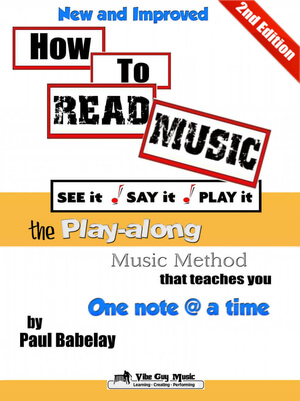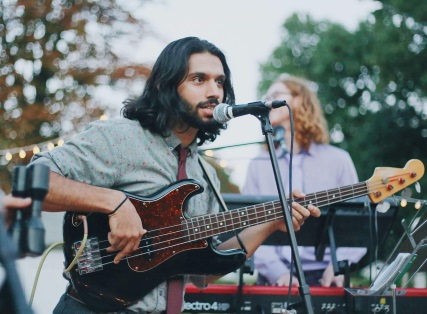Can you learn to read music?
YES! And it’s easier, faster and cheaper, when you do it the Right way.
Here’s the truth…
You CAN’T learn how to read music from a book.
You need a proven SYSTEM, created by real, professional musicians – NOT publishers and marketing pros.
Learning How to Read Music can Give You several Advantages
Of course, knowing how to read music is no guarantee of a successful music career. But, If there was ever a time to know all you can about music, from Music Theory to Production – it’s today.
The 21st century musician should be as prepared as possible. Some gigs don’t require music reading skills, but many others do.
As a result, a professional musician should try and prepare for any musical opportunity. Knowing how to read music is simply a tool to help you be the best musician you can be.

Good News!
My book, How To Read Music – SEE it, SAY it, PLAY it will soon be an online course. The lessons, exercises, mp3s, videos and pdfs will be available with a subscription plan. You can subscribe for a month, 3 months or a lifetime – as needed. Stay tuned.
Be Prepared for All Opportunities
Music Reading Skills Can Equal More Gigs
Learning how to read music is not just for “classical” musicians. For example, there are many gigs today that require you to read charts, lead sheets and sheet music.
- Musical Theater
- Studio Musician
- Conductor
- Arranger
- Composer and more…
Plus – you can hop on a plane, listen to a band’s playlist on the trip, write your own cheat-sheet charts… and play their gig. You might be the “go-to-pro” in an emergency situation.
True, it is not required for all musicians to learn how to read music. But on the other hand, why miss any opportunity to play… AND GET PAID?
above all
reading music helps you stop guessing

Increased Musical Knowledge
Ear Training
Confidence
Stop faking
Practical Music Theory
More Gig Opportunities
Notate Your Own Music
Read Charts
Visual, Aural and Motor Skill-Stacking
Fun and personal enrichment
In addition
Learning How to Read Music can stack Many Skills at Once
Because, when you learn how to read music correctly, you are empowered in 4 areas:
- Aural Skills
- Visual Skills
- Motor Skills
- Confidence
The right system for learning how to read music isn’t frustrating. Instead, it can be as natural as learning your own language.
Aural Skills
To learn music notation the right way accelerates ear training. After all – Music is sound, not graphics.
Visual Skills
Our one-note-@-a-time system will build your vocabulary but avoid information overload.
Motor Skills
Learning to read music will connect your eyes, ears, brain and hands. It’s a powerful combination.
confidence
When you understand notes, rests, time signatures and the basic rhythms of music – you can relax and play.

The Secret Sauce
Reading Music: Old-School Secrets of The Pros
There’s a thousand ways to do anything. But only a few are successful.
As much as I like new stuff – the old-school methods rule when learning how to read music.
CONCERNS
MYTHS
SOLUTIONS
Why should I learn how to read music?
Simple.
To be better equipped for whatever you want to do with music. It’s not going to make you rich and famous, but it won’t hurt your career either.
It’s a tool for any musician that wants to be more valuable in the marketplace. For some gigs, it’s essential. For others, it doesn’t matter.
So, what about you? To help you decide you can read the article, “Learn to Read Music – 5 Reasons You Should” for ideas.
Why is reading music so hard?
oIt isn’t.
You’ve been trying to learn to read music the hard way. The wrong way.
Unfortunately, many people are taught by a weak process that creates information overload. It’s too much stuff to process and it IS hard. It’s almost impossible.
That’s why I wrote How To Read Music – See it, Say it, Play it.
You learn one note @ a time.
As you learn it, you will play along with music tracks. These songs are specially written for one note, then two notes, then three…etc.
As a result, you learn basic music vocabulary AND how to read music.
It works!
What's different about How To Read Music - See it, Say it, Play it?
Everything!
First off – you can’t learn to read music from a book.
Learning the music language should engage your ears, eyes, motor skills and more. 99% of the books on the market just give you symbols to memorize.
THAT’S LIKE LEARNING TO SWIM FROM A BOOK.
I want to laugh out loud (so I won’t cry) when I see these books claiming to teach how to read music.
- This is a staff.
- This is a measure.
- This is a Time Signature.
And this is a pill, and this is a scalpel, and this is a heart, and this is a tumor.
But that isn’t teaching me to be a doctor. Those are just terms.
It Doesn’t Work
There are so many frustrated people out there that have tried really hard to read music.
And the process itself can do more harm than good.
I don’t mean to be negative about any other books, methods and courses. If nothing else, you can get exposed to musical terms and symbols.
But, you need a strategy, a system that puts it all together for you.
This gives an ADVANTAGE – not a roadblock to reading music.
I'm Afraid I'll Lose My Individual Style if I Learn to Read Music
Your concern is a good one.
But your reasoning is wrong.
Nobody should lose their individuality – especially musicians. If you have heard me or read any of my material, I encourage you to find and develop your unique musical voice.
But – learning the alphabet didn’t hurt your style. Learning to read and write your language didn’t hurt either.
Instead, it helps you express yourself.
When you hear aspiring musicians sound like robots, that’s due to bad teaching and wrong understanding – not reading music.
Yes, you can develop bad habits and weak performance techniques when learning to read music.
Therefore, learn the right way, and you’ll be good.
My Favorite Musician Doesn't Read Music
This affects your music career how?
What is See it, Say it, Play it?
A step-by-step system to learn the music language one-note-at-a-time.
- I teach you to SEE/Recall Music Notes in context.
- SAY it (speak the rhythm correctly – just like you would play it).
- And PLAY it in real time, in real music, on a real instrument.

You mentally “see” it – because you know the musical math.
You’re able to “say” it because you know the vocabulary.
And eventually you’ll be ready to play/perform the music with feeling and emotion.
SSP (See it, Say it, Play it) stacks your visual, aural and motor skills.
So, if learning how to read music has left you frustrated and confused… Try our way. It works.
Questions &
suggestions
send questions and comments.
Your information will never be sold or given away. We Hate spam!

